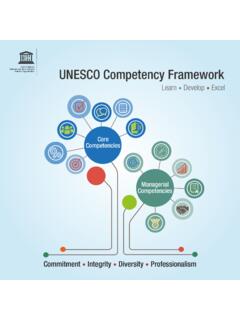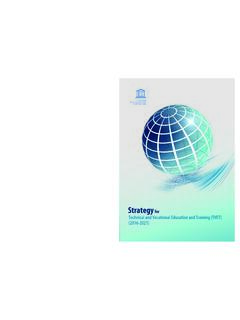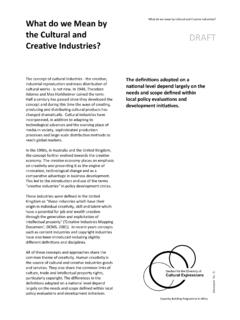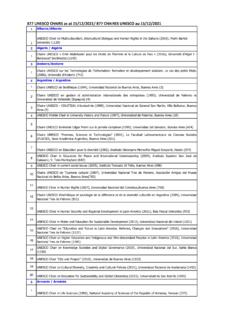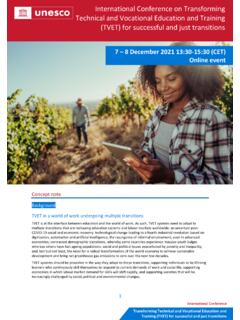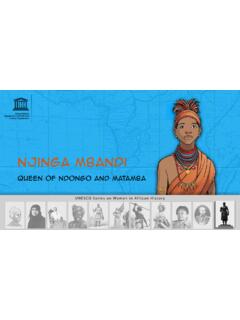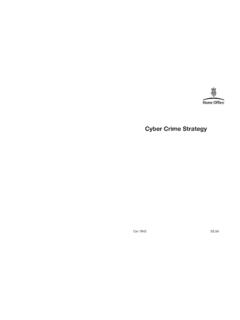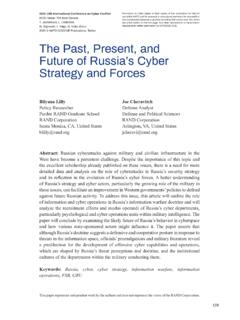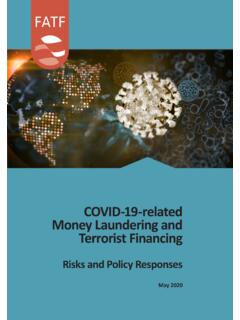Transcription of CYBER VIOLENCE AGAINST WOMEN AND GIRLS - UNESCO
1 CYBER VIOLENCE AGAINST WOMEN AND GIRLSA WORLD-WIDE WAKE-UP CALL A REPORT BY THE UN BROADBAND COMMISSION FOR DIGITAL DEVELOPMENT WORKING GROUP ON BROADBAND AND GENDER 2015 Photo credits:ShutterstockCYBER VIOLENCE AGAINST WOMEN AND GIRLS : A WORLD-WIDE WAKE-UP CALLA cknowledgementsThis Report has been written collaboratively, drawing on insights and rich contributions from a range of Commissioners and Expert Members of the Working Group on Broadband and Gender. It has been researched and compiled by lead author Nidhi Tandon, assisted by Shannon Pritchard, with editorial inputs by teams from UN WOMEN , UNDP and concepts were developed by C line Desthomas of ITU.
2 We wish to thank the following people for their contributions and kind review and comments (listed in alphabetical order of institution, followed by alphabetical order of surname): Dafne Sabanes Plou, Jac sm Kee and Chat Garcia Ramilo (APC); Dr Nancy Hafkin; Minerva Novero-Belec (UNDP); Corat Suniye Gulser ( UNESCO ); Jennifer Breslin and team (UN WOMEN ); Samia Melhem and team (World Bank).About the CommissionThe Broadband Commission for Digital Development was launched by the International Telecommunication Union (ITU) and the United Nations Educational, Scientific and Cultural Organization ( UNESCO ) in response to UN Secretary-General Ban Ki-moon s call to step up efforts to meet the Millennium Development Goals.
3 Established in May 2010, the Commission unites top industry executives with government leaders, thought leaders and policy pioneers and international agencies and organizations concerned with Broadband Commission embraces a range of different perspectives in a multi-stakeholder approach to promoting the roll-out of broadband, as well as providing a fresh approach to UN and business engagement. To date, the Commission has published a number of high-level policy reports, best practices and case studies. More information about the Commission is available at opinions, analyses and recommendations contained in this report do not necessarily reflect the views of UN WOMEN , the United Nations Development Programme (UNDP) and its Executive Board, or of the United Nations Member rights are reserved.
4 No part of this publication may be reproduced, by any means whatsoever, without the prior authorization of Broadband Commission co-Vice Chairs ITU or UNESCO . The designations employed and the presentation of material throughout the publication do not imply the expression of any opinion whatsoever on the part of ITU and UNESCO concerning the legal status of any country, city or area or of its authorities, or concerning its frontiers or boundaries. Executive summary ..11. Why the Broadband Commission for Digital Development needs to lead on CYBER VIOLENCE AGAINST WOMEN and GIRLS .
5 CYBER -VAWG is a systemic societal concern and challenge .. The time to act is now .. Objectives and limitations of this report ..102. The evolution of the Internet and its ramifications for CYBER VAWG .. What the numbers tell us .. How the Internet is perceived trust, safety and freedom ..173. Defining the threat environment: the CYBER nature of VAWG .. Terminologies, definitions and trends .. Characteristics and profiles of CYBER VAWG .. CYBER VAWG AGAINST the backdrop of CYBER -crime ..264. Tackling CYBER VAWG: a multi-level approach.
6 Pursuing a multi-level approach .. Sensitization: changing societal norms .. Safeguards: working with industry and users to make the Internet VAWG-safe .. Sanctions and compliance: Frameworks, Law and its application ..385. A View to ending CYBER VAWG through partnerships and coalitions ..456. Conclusions and principles for further action ..47 Bibliography ..49 End Notes ..55 ABBREVIATIONS AND ACRONYMSAPC Association for Progressive CommunicationsCEDAW Committee on the Elimination of all forms of Discrimination AGAINST WomenICT Information and Communication Technology IGF Internet Governance ForumISPs Internet Service Provider(s)
7 OSCE Organization for Security and Co-operation in EuropePTSD Post-Traumatic Stress Disorder SNS Social Networking Service/SiteUGC User Generated ContentVAWG VIOLENCE AGAINST WOMEN and Girls1 EXECUTIVE SUMMARYM illions of WOMEN and GIRLS around the world are subjected to deliberate VIOLENCE because of their gender. VIOLENCE AGAINST WOMEN and GIRLS (VAWG) knows no boundaries, cutting across borders, race, culture and income groups, profoundly harming victims, people around them, and society as a growing reach of the Internet, the rapid spread of mobile information and communications technologies (ICTs) and the wide diffusion of social media have presented new opportunities and enabled various efforts to address However, they are also being used as tools to inflict harm on WOMEN and GIRLS .
8 CYBER -VAWG is emerging as a global problem with serious implications for societies and economies around the world. The statistics pose risks to the peace and prosperity for all enshrined in the Charter of the United Nations, and, in par ticular, to the goals of inclusive, sustainable development that puts gender equality and the empowerment of WOMEN as key to its achievement. Writing this repor t has, in some sense, been a race to keep up with breaking news, as girl after girl and woman after woman, has come forward to expose physical and verbal attacks on them: teenage GIRLS driven to suicide by online trolling; an airline passenger using her cell phone to record and report physical and sexual harassment from a male co-passenger; an actress publicly responding to targeted online hate speech AGAINST her.
9 A former Major League Baseball pitcher using doxing3 to identify people responsible for Twitter troll posts with obscene, sexually explicit comments about his teenage daughter. A current Twitter hashtag4 shows just how rough it is being a woman on the Internet in North America. WOMEN of the Global South also experience various acts of CYBER VAWG, but these are usually less profile incidences attract public attention and tor t law responses: aTwitter troll was jailed5 in September 2014 and a porn site operator sentenced to 18 years in in prison in February 20156.
10 One person was suspended from his community college, and another lost a part-time job with the New York Yankees when the doxing case involving a former Major League Baseball pitcher was made public. In May 2015, a Toronto sports reporter was verbally assaulted while broadcasting live at a professional soccer league game. Following public outrage, the main 2aggressor lost his high paying job at a public corporation. The sports team also banned four of the offenders from the stadium. Responses, however, have yet to fully address the many degrees and impact of VIOLENCE , trauma and loss that WOMEN , GIRLS and children are routinely exposed to and that go unreported.

